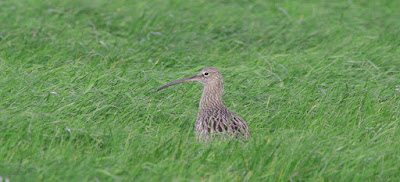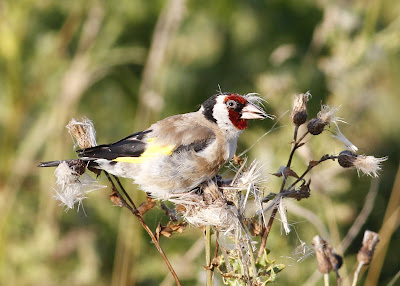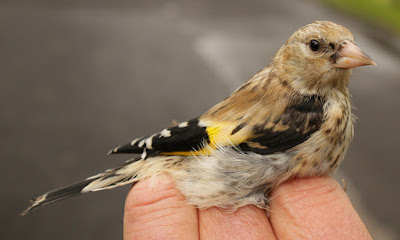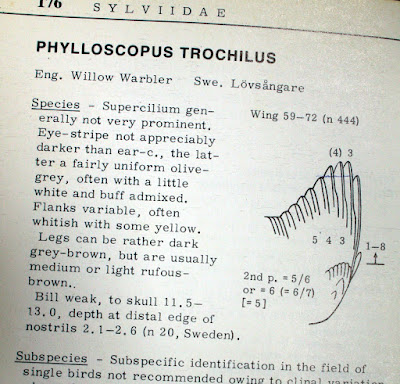Being banned from bird ringing other than in one's own garden is frustrating and annoying. More so when the authorities continue to allow both shooting and fishing to take place in the countryside. We are hopeful that we may be able to recommence our vital conservation work soon.
In the meantime. A couple of recoveries of ringed birds remind us of previous ringing sessions.
We caught and ringed Lesser Redpoll Y596566 at Oakenclough way back on 4 February 2015 as a first winter female. It certainly looked like a female and also measured at 72mm wing. Below is the picture from that day, easily retrieved from the blog because it was the only redpoll caught.
“There was a slight frost with both clear skies and the radio forecast promising a sunny day ahead. Our four hours proved to be rather slow in both activity and numbers caught whereby we speculated that birds had moved from this high ground location to more urban locations a mile or three away where the temperatures would be more to their liking.
We caught just 25 birds, 21 new ones and 4 recaptures. New birds: 8 Blue Tit, 6 Great Tit, 3 Chaffinch and singles each of Goldfinch, Lesser Redpoll, Coal Tit and Robin. Recaptures: 2 Chaffinch and 1 each of Robin and Coal Tit.“
Fast forward to 26 January 2021, 5.98 years later and Y596566, the single Lesser Redpoll of 4 February 2015 was recaptured by Durham Dales Ringing Group at Rowlands Gill, Tyne and Wear, some 126 kms from Oakenclough.
By now and with the now mature bird, Durham Dales ringers were able to more accurately age this bird as an adult male rather than the female we supposed 5 years earlier.
Such is the danger and associated pitfalls of trying to age and sex first winter Lesser Redpolls where it is wrong to commit a bird's age to a database unless 99% positive.
Hopefully we ringers learn from our mistakes. Unless of course it was a simple data input error of “F” instead of “M”! That's our excuse and we're sticking to it.
=============================
Although we have been unable to continue with our wintering Project Linnet because of the virus yet another Linnet recovery has come to light.
This one again involves the island of North Ronaldsay, Northern Isles and an old friend, a male Linnet carrying Ring Number AJD6518.
We caught AJD6518 for the first time at Gulf Lane Pilling Marsh on 26 November 2018. The same bird has now been recaptured on three separate occasions at Holland House, North Ronaldsay Bird Observatory - 7 May 2019, 28 June 2019 and the latest one on May 2020.
Linnet - North Ronaldsay to Pilling
Where this individual has been during the winter of 2020 is anyone guess but we rather hope it came back to Lancashire again, even though we were unable to prove the likelihood when bird ringing became verboten.
After this latest information about Linnets' status on North Ronaldsay I made contact with George Gay who has the privilege of a working life on this outpost of bird migration.
George - “The Linnets on the island leave over the winter and usually return sometime in March in dribs and drabs. Holland is not only a roost site but their main breeding site on the island.
Since 1987 we have ringed just over 7000 Linnets here but they haven't bred until fairly recently and have largely replaced Twite as a breeder on the island.
Holland is the main site but birds do breed elsewhere on the island with Ancum Willows probably being the next most likely spot to find breeding birds. They've been on a steady increase since the late 90's to early 2000's and now roost flocks can easily reach 300-400 birds post breeding.”
The information above mirrors the summaries of the Linnets' status in both the BTO Migration Atlas 2002 and the BTO Bird Atlas of 2013, both of which tell of the Linnets' colonisation of the Northern Isles of Scotland during its simultaneous decline as an English farmland species.
Two other records also show our now regular Lancashire/Northern Isles connections.
Ring number AYD5167 was ringed as a post breeding individual at Holland House, North Ronaldsay on 8 September 2018, a rather large juvenile male of wing length 84mm. We recaptured the same bird at Gulf Lane, Pilling, Lancashire on 24 December 2018. Here is a clear case of juvenile dispersal/migration.
The above correspond to yet another Linnet that spent time at our winter set aside of Gulf Lane. Z722984 was ringed as a nestling of 6 siblings at Scousburgh, Shetland, 14 June 2016 and later recaptured at Gulf Lane, Pilling on 24 October 2016 - A juvenile heading south-west to spend the winter in England. This is more support for the idea about the origins of many Linnets that flock to spend the winter in the area of Pilling and Cockerham, the same birds that then depart in March to head north to Scotland.
Linnets
The value of bird seed and cover crops in many English locations becomes apparent as does the need for constant monitoring to spot changes taking place in the countryside.
Linnets
Come on Boris, Natural England and BTO, give us our ringing back. We much prefer it to shooting or fishing. Don't you?
=============================
Back home in the garden 2020/2021 has proved a peculiar winter with almost zero bird activity apart from the occasional Goldfinch and Blackbird.
Goldfinch
Perhaps the continuous unsettled weather has caused birds to move elsewhere to seek food. The grass is squelchy through the endless rain with no opportunity for it to dry out. Days of sunshine are rare with the chances of catching a few birds remote.
Stay tuned friends. We may be banned but we haven't given up hope of a return to ringing soon.
































































.jpg)


















